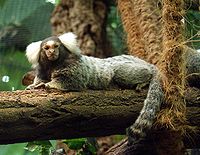
Photo from wikipedia
The vocal sequences of marmosets exhibit many drastic changes during infancy. One of the most pronounced of these is the gradual convergence from a variety of call types in the… Click to show full abstract
The vocal sequences of marmosets exhibit many drastic changes during infancy. One of the most pronounced of these is the gradual convergence from a variety of call types in the undirected context to long distance contact calls (aka phee calls). We conjecture that such change is attributed to the interplay between the neural fluctuation and the biomechanics of the developing vocal periphery. To explore such possibility, we first quantitatively characterize vocal sequences and correlate them with animal momentary arousal levels. Based on this, we show that the diversity of respiratory and laryngeal patterns, as well as the commonly produced sequence transitions, can be generated via simple coupled oscillators with a low-dimensional input. In addition, the model predicts that as the respiratory apparatus grows, not only does the oscillatory period increase, but also the proportions of call types become biased towards phee calls. We further empirically test this hypothesis by placing the marmoset infants in a helium-oxygen (heliox) environment where the much lighter air reduces vocal effort, simulating smaller lungs. Consistent with the model prediction, the heliox manipulation reduces phee call duration and increases the proportion of other call types.The vocal sequences of marmosets exhibit many drastic changes during infancy. One of the most pronounced of these is the gradual convergence from a variety of call types in the undirected context to long distance contact calls (aka phee calls). We conjecture that such change is attributed to the interplay between the neural fluctuation and the biomechanics of the developing vocal periphery. To explore such possibility, we first quantitatively characterize vocal sequences and correlate them with animal momentary arousal levels. Based on this, we show that the diversity of respiratory and laryngeal patterns, as well as the commonly produced sequence transitions, can be generated via simple coupled oscillators with a low-dimensional input. In addition, the model predicts that as the respiratory apparatus grows, not only does the oscillatory period increase, but also the proportions of call types become biased towards phee calls. We further empirically test this hypothesis by placing the marmoset infants in a...
Journal Title: Journal of the Acoustical Society of America
Year Published: 2018
Link to full text (if available)
Share on Social Media: Sign Up to like & get
recommendations!